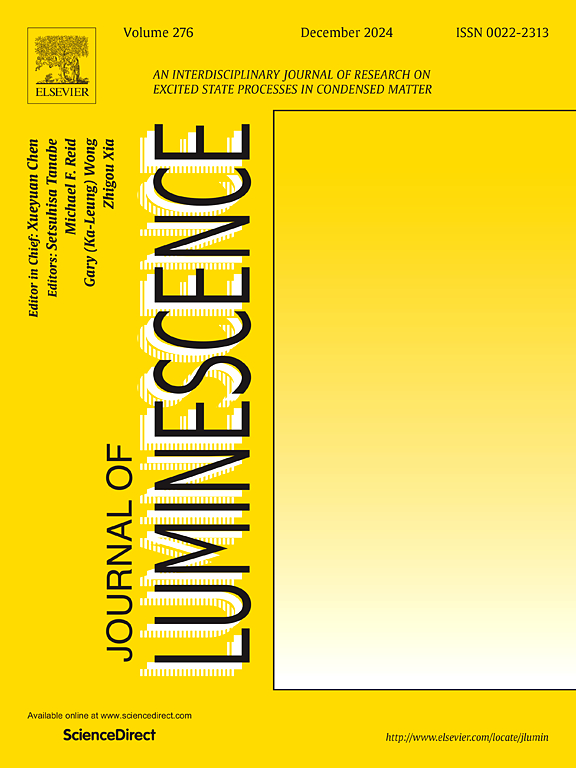Optical properties, changes in electronic transitions in solvent media and dipole moments of nematic liquid crystals containing cyano group: Absorbance, fluorescence spectroscopy and reactivity parameters
IF 3.3
3区 物理与天体物理
Q2 OPTICS
引用次数: 0
Abstract
In this study, electronic structure, solvatochromic properties, optical properties and reactivity parameters of liquid crystal compounds in solvent media with different polarities were investigated. Electronic absorbance and fluorescence spectra of 2-Cyano-4′-bromomethylbiphenyl (BROMO-OTBN) and 4-Cyano-4′-pentyloxybiphenyl (5-OCB) nematic liquid crystals (NLCs) containing cyano group were measured in many different solvent media. The electronic transitions of BROMO-OTBN and 5-OCB LCs were interpreted solvent-dependent wavelength shifts. The effects originating from changes in electronic transitions depending on the solvent media were described using linear solvation energy relationships (LSERs), too. The effect of solvent on electronic structure was investigated using polarizability, polarity and hydrogen bonding capacities. Electric dipole moments in solvent media were calculated using different quasi-quantum mechanical methods. It was found that the solvent acceptance radius of BROMO-OTBN NLC was smaller than that of 5-OCB, while the electric dipole moment of BROMO-OTBN was larger. The charge disorder in the excited state of 5-OCB is significantly larger than that in the ground state. The angle change between the ground and excited dipole moments of 5-OCB is smaller than that of BROMO-OTBN. This is due to the twisted intramolecular charge (TICT) transfer resulting from steric effects during the fluorescence electronic transition. The band gap energy and refractive index of liquid crystals have also been calculated experimentally. The forbidden band gap energy varies from 3 to 3.9 eV and the refractive indices are obtained in the range of 1.3–2.6 depending on the solvent.

含氰基向列液晶的光学性质、溶剂介质中电子跃迁的变化和偶极矩:吸光度、荧光光谱和反应性参数
研究了液晶化合物在不同极性溶剂介质中的电子结构、溶剂致变色性质、光学性质和反应性参数。测定了含氰基的2-氰基-4′-溴甲基联苯(BROMO-OTBN)和4-氰基-4′-戊氧基联苯(5-OCB)向列相液晶(NLCs)在不同溶剂介质中的电子吸光度和荧光光谱。BROMO-OTBN和5-OCB lc的电子跃迁被解释为溶剂依赖的波长位移。利用线性溶剂化能关系(LSERs)描述了由溶剂介质的电子跃迁变化引起的影响。从极化率、极性和氢键能力等方面考察了溶剂对电子结构的影响。采用不同的准量子力学方法计算了溶剂介质中的电偶极矩。结果表明,溴代otbn NLC的溶剂接受半径小于5-OCB,而溴代otbn的电偶极矩较大。5-OCB激发态的电荷无序性明显大于基态。5-OCB的地面偶极矩与激发偶极矩的夹角变化比溴化硼的小。这是由于在荧光电子跃迁过程中,由空间效应引起的扭曲分子内电荷(TICT)转移。对液晶的带隙能和折射率进行了实验计算。禁带能在3 ~ 3.9 eV之间变化,折射率随溶剂的不同在1.3 ~ 2.6之间变化。
本文章由计算机程序翻译,如有差异,请以英文原文为准。
求助全文
约1分钟内获得全文
求助全文
来源期刊

Journal of Luminescence
物理-光学
CiteScore
6.70
自引率
13.90%
发文量
850
审稿时长
3.8 months
期刊介绍:
The purpose of the Journal of Luminescence is to provide a means of communication between scientists in different disciplines who share a common interest in the electronic excited states of molecular, ionic and covalent systems, whether crystalline, amorphous, or liquid.
We invite original papers and reviews on such subjects as: exciton and polariton dynamics, dynamics of localized excited states, energy and charge transport in ordered and disordered systems, radiative and non-radiative recombination, relaxation processes, vibronic interactions in electronic excited states, photochemistry in condensed systems, excited state resonance, double resonance, spin dynamics, selective excitation spectroscopy, hole burning, coherent processes in excited states, (e.g. coherent optical transients, photon echoes, transient gratings), multiphoton processes, optical bistability, photochromism, and new techniques for the study of excited states. This list is not intended to be exhaustive. Papers in the traditional areas of optical spectroscopy (absorption, MCD, luminescence, Raman scattering) are welcome. Papers on applications (phosphors, scintillators, electro- and cathodo-luminescence, radiography, bioimaging, solar energy, energy conversion, etc.) are also welcome if they present results of scientific, rather than only technological interest. However, papers containing purely theoretical results, not related to phenomena in the excited states, as well as papers using luminescence spectroscopy to perform routine analytical chemistry or biochemistry procedures, are outside the scope of the journal. Some exceptions will be possible at the discretion of the editors.
 求助内容:
求助内容: 应助结果提醒方式:
应助结果提醒方式:


